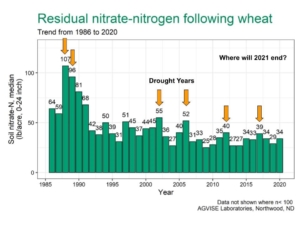Lessons (Ghosts) of Droughts Past
From Alberta to Iowa, the region has experienced everything from abnormally dry soil conditions to exceptional drought. In some places, the drought started in 2020 and has continued through 2021. Considering lower than expected crop yields, we expect that residual soil nitrate-nitrogen levels will be much higher than normal in many wheat, canola, and corn fields this fall. There was reduced crop nitrogen uptake and little to no soil nitrogen losses to leaching or denitrification through the growing season, which should result in higher soil test nitrate-N remaining in the soil profile.
In major drought years, high residual nitrate levels are a normal phenomenon. In 1988, the average soil nitrate test following wheat across the region was a staggering 107 lb/acre nitrate-N (0-24 inch soil profile). This is considerably higher than the long-term average around 30-45 lb/acre nitrate-N (0-24 inch soil profile). The 1988 drought was extreme, and 2021 has rivaled that in some locations. Based on previous drought years, it will be no surprise to find wheat fields with 80-100 lb/acre nitrate-N (0-24 inch soil profile) or even higher.
Past experience also shows us that drought can create greater crop yield variability across fields. Some zones in the field with better water holding capacity and soil organic matter may have produced a decent crop yield, and these will have lower residual soil nitrate-N. Yet, other zones may have had very poor crop growth and yield, leaving very high amounts of soil nitrate-N remaining.
Zone soil sampling is always a good idea, but it is especially important in drought years. Soil sampling based on productivity zones is the only way to determine the correct amount of nitrogen fertilizer in each zone across the field. To create good productivity zones for soil sampling, it is best to use multiple data layers such as satellite imagery, crop yield maps, topography, or electrical conductivity (Veris or EM38).
This fall, we expect residual soil nitrate-N to be higher than normal, but there will be exceptions to the rule. Last spring, there was a lot of broadcast urea fertilizer applied without incorporation. If no rain was received for several weeks after application, much of the nitrogen could have been lost to ammonia volatilization. This means some fields will seem out of place with lower residual soil nitrate-nitrogen because fertilizer nitrogen was lost last spring.
For fields with more than 150 lb/acre nitrate-N (0-24 inch soil profile), the crop nitrogen requirement for next year may not call for much, if any, nitrogen fertilizer. We must remember that drought creates variability within a field and even within large productivity zones. This is why we always suggest applying a base amount of nitrogen fertilizer to address the variability, even if the soil nitrate test is more than 150 lb/acre nitrate-N. A base nitrogen fertilizer rate (maybe 20 to 40 lb/acre N) should address most of the field variability and provide a fast start to the next year’s crop. In 1988, we learned the tough lesson that applying no nitrogen fertilizer on fields testing very high for nitrate-N was a mistake, and the best producing parts of fields had early-season nitrogen deficiencies. A modest base nitrogen fertilizer rate was the right decision to cover field variability.
Three Simple Lessons from Droughts Past
- Soil test all fields for residual soil nitrate-N. There will be considerable variability from field to field and even zone to zone.
- The residual soil nitrate-N test allows you to reduce nitrogen fertilizer rates for next year, saving money on crop inputs for 2022.
- Remember to apply a modest base nitrogen fertilizer rate on fields testing very high in nitrate-N to address field variability. You will want to get next year’s crop started right.
